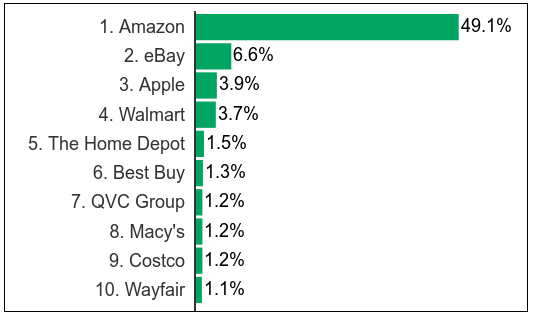Introduction
Many companies use powerful models and strategies to deliver high-quality products and services to their customers. Amazon focuses on powerful initiatives and practices that can promote performance and improve customer satisfaction. This paper gives a detailed analysis of the organization’s market share and pricing decisions.
Market share
Every industry has its leading players or competitors. Each company has its market share and strives to maximize it using evidence-based strategies. Izogo and Ozo (2015) define it as the representation of what a specific organization earns in a particular sector over a specified period. Analysts can use total sales to calculate the market share of a specific business.
Amazon’s Market Share
Amazon’s original business model revolves around the concept of an online bookstore. The introduction of new tactics has made it a leading competitor in the United States’ e-commerce sector. Since many people are embracing online transactions, chances are high that Amazon will remain a dominant player in its industry. Currently, it commands a total market share of 49.1 percent of the country’s e-commerce sector (Lunden 2018). Its closest competitors include eBay, Apple, and Walmart. These companies have market shares of 6.6%, 3.9%, and 3.7% (Lunden 2018). Other key players in the sector include Best Buy, QVC Group, Macy’s, and The Home Depot (see Figure 1). In the wider retailing industry, Amazon has a share of 5 percent (Lunden 2018). This is the case since Walmart and Best Buy use physical stores and outlets across the US to increase sales.

Losing Market Share
The presented case study reveals that Amazon is currently losing its market share in e-book retailing. This is the case since new competitors have emerged that are providing similar services at reduced prices. This development means that Amazon should be concerned since it stands a chance to become less profitable. Emerging competitors provide different platforms that are accessible and affordable (Lunden 2018). With this kind of knowledge, Amazon needs to develop a superior model for attracting more customers, revisiting its prices, and diversifying its e-books in order to remain competitive.
Amazon’s Pricing Decisions: Implications
Due to the increased pressure from publishers, this company chose to increase its prices for various e-books and other digital content (Weise 2019). Although its sales for different products still remain high, Amazon’s pricing decisions might present negative effects despite its enjoyable market share. Firstly, such an initiative means that the company has to consider the bargaining power of different suppliers and publishers. The emergence of new competitors providing such products at reduced costs will result in reduced market share (Robischon 2017). Secondly, the pricing decisions are unsustainable and incapable of addressing customers’ demands.
Thirdly, the instability of this company’s prices means that different customers might opt for other e-retailers and providers of digital content (Demir 2017). This development will result in reduced sales, thereby affecting profitability. Since its prices are still low in comparison with those of its key competitors, chances are high that Amazon will still remain profitable. It would, therefore, be appropriate for this corporation’s leaders to consider the trends recorded in the e-commerce sector and develop an evidence-based pricing strategy that can reduce the level of rivalry.
Conclusion
The above discussion has revealed that Amazon is a leading player and competitor in the American e-commerce industry. Unfortunately, its pricing strategy remains unstable and incapable of meeting the changing needs of all potential customers. A superior model is needed to transform the situation and ensure that this company remains competitive.
Reference List
Demir, A 2017, ‘Management information system: case study of Amazon.com’, Journal of Research in Business and Management, vol. 4, no. 11, pp. 11-17.
Izogo, EE & Ozo, JU 2015, ‘Critical evaluation of how well placed Amazon is to sustain its historical in online retailing’, British Journal of Marketing Studies, vol. 3, no. 6, pp. 31-42.
Lunden, I 2018, ‘Amazon’s share of the US e-commerce market is now 49%, or 5% of all retail spend’, Tech Crunch, Web.
Robischon, N 2017, ‘Why Amazon is the world’s most innovative company of 2017’, Fast Company, Web.
Weise, K 2019, ‘Amazon knows what you buy. And it’s building a big ad business from it’, The New York Times, Web.